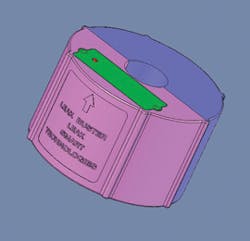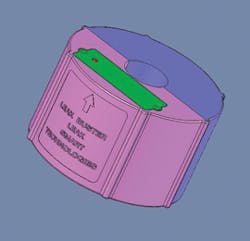So critical is the issue that the American Society of Civil Engineers (ASCE) has given the nation’s water infrastructure system a 2009 grade of D-.
“The nation’s drinking water systems face staggering public investment needs over the next 20 years,” according to the ASCE report card. “Although America spends billions on infrastructure each year, drinking water systems face an annual shortfall of at least $11 billion in funding needed to replace aging facilities that are near the end of their useful life and to comply with existing and future federal water regulations.”
That shortfall does not account for any growth in the demand for drinking water over the next 20 years, the ASCE adds.
The California Water Department cites several factors in the need for the crisis to be immediately addressed:
- Leaks enlarge with age.
- Leak repairs reduce increased water loss.
- Repairing leaks with regularly scheduled maintenance reduces overtime costs incurred through unscheduled repairs and provide more treated, pressurized water to sell to customers.
- Leak detection and repair reduces power costs to deliver water and chemical costs to treat it.
- Leaks have caused damage to nearby roads, other infrastructure, and sometimes buildings. Some water utilities conduct frequent leak detection and repair programs near unstable geologic areas to reduce legal liability against expensive lawsuits.
- Through leak detection and repair, the public appreciates seeing that its water systems are being maintained and the utility gains credibility by putting its own house in order
before asking the customers to conserve water.
Steve Allbee is a project director for the EPA and the principal author of The Clean Water and Drinking Water Infrastructure Gap Analysis. The 2002 analysis concluded the funding gap for replacing aging pipes would be an estimated $27 billion a year over 20 years.
“As a nation, I believe we have begun to understand the huge challenges presented by our aging water assets,” says Allbee. “Because investment needs are so significant, it is absolutely essential we operate facilities as efficiently as possible.”
That means maximizing the use of every dollar required, Allbee says. “Our customers and ratepayers expect us to manage our systems with appropriate practices that are prudent and financially sound,” he adds. “Whatever the specifics, losing massive amounts of treated water can’t be a good thing. Frequently, taking action is just common sense and responsible stewardship. We ought to get to it.”
Allbee says there are many water utilities doing a “terrific job” managing their situations. “However, generally accepted figures on unaccounted-for water range from 10% to more than 20%,” he points out. “Now and then, you can even find reference to circumstances where water losses are reported to be as high as 60%. If you put this in the context of the many communities experiencing drought conditions, it’s simply not acceptable. We can, and must, do better.”
Water utilities should drive toward to goal of getting water loss down to about 4%, Allbee says. “Obviously, you don’t know your options unless you understand your system’s condition,” he explains, adding that water audits and leak detection activities play a key role in doing so.
“Over the past decade, the tools and techniques have improved,” continues Allbee. “Utilities are making use of technology, such as acoustic monitors, to help them control water loss. There are reports of recouping an investment within less than a year.
“The range of knowledge associated with leak detection, asset management, and pipe rehabilitation shouts opportunity to improve performance,” he adds. “This is one of those occasions where a “˜win-win’ scenario is very real. You do what’s right for the environment, and you save money.”
Long-term, the country’s objective in managing water loss is moving toward identifying and managing failure before it occurs or at least manage losses early on, Allbee says. “Small leaks can become major breaks causing significant disruption. Too many significant disruptions, and a utility will lose the confidence of its customers, which is another loss they surely can’t afford.”
The final installation of wireless leak detectors by The Metropolitan Water District of Southern California is still in the early stages of implementation.
While water treatment is pretty well regulated and under control, “in my professional opinion, the distribution system is in the worst shape,” says Zane Satterfield, an engineering scientist with the National Drinking Water Clearinghouse of the National Environmental Services Center at West Virginia University.
“There are some systems that have done recent updates through their own funding or even through United States Department of Agriculture Rural Development grants,” he adds. “But still, a vast majority of the distribution systems for drinking water for customers are very aged. That’s probably the biggest undertaking out there.”
With the goal of promoting monitoring and maintenance as a key strategy in bridging the funding gap for replacing aging pipes, the EPA has awarded DC Instruments, in Thousand Oaks, CA, nearly $70,000 in funding for the first phase of a Small Business Innovation Research project for water infrastructure rehabilitation. The project began in February and is expected to last through the end of July.
The purpose of the proposed innovation is to use audible data loggers and wireless telemetry to record and transmit sound data to a surface and underground wireless network, then relay the consolidated information to the Internet.
When the acoustic data is available over the Internet, leaks can be located by using leak-pinpointing software, followed by repair efforts and further preventative maintenance measures. Multiple units can be installed permanently within the water infrastructure for ongoing leak monitoring.
The approach has achieved practicality through the recent advent of low-power and low-cost ZigBee wireless protocol and environmentally friendly batteries with an extended life of more than 10 years. Daniel Chang, president of DC Instruments, points out three problems inherent in the nation’s water distribution system.
“The first problem is the infrastructure for water distribution and sewage systems is too old–it’s aging and requires replacement,” says Chang, adding that 10% of the nation’s pipes exceed 80 years old, 30% are between 40 and 80 years old, and 60% are under 40 years old.
“The second problem is there is a lot of corrosion in the pipes,” adds Chang. “It’s not possible to replace all of the pipes, because it’s too much money due to the Congressional funding gap. The funding gap is $27 billion a year; it’s huge money.
The third problem is that there is no way all of the pipes can be replaced at once, says Chang, “so there has to be some strategy.”
That strategy, says Chang, is “to have very good maintenance and only repair the pipes that are broken. Good maintenance will increase the life cycle of water distribution and the sewer systems. Consequently, based on the statistics and using the funding group, the most critical criterion for pipe replacement is the leak in the pipes.”
In his proposal to the EPA, Chang references the federal agency’s 2002 report that shows two scenarios. Under a “no-revenue growth” scenario, a 20-year gap of capital and operation/maintenance costs for clean water and drinking water would add up to $534 billion ($27 billion per year) in 2001. Under a “3%–per year revenue growth” scenario, the gap would total $86 billion ($4 billion per year) in 2001.
The primary focus of DC Instrument’s innovation is in developing the underground wireless communication network. Because standard transmission frequencies in surface networks do not function as well in the subterranean environment due to increased interference from thick layers of soil, it is necessary to conduct research using low frequencies in order to propagate through different types and thicknesses of soil, and determine the RF ranges at which a leak detector network would function.
During the first phase of the project, a network will be established between two sensors. After that is completed, the second phase will focus on establishing the network among multiple sensors. Many economic and environmental efficiencies are expected to be derived from the project’s success. Water leak surveys can be costly, involving expenses in human labor and high-cost transportation.
The use of DC Instruments’ Wireless Leak Detector is expected to reduce water consumption by up to 17% and electricity by up to 0.66 trillion kWh a year.The potential commercial applications for the technology include water leak detection, gas leak detection, structure failure detection, and geological surveys within an estimated $1-billion market.
DC Instruments has been in business for three years and employs eight consultants. The company won a 2007 Metropolitan Innovative Conservation Program award from the Metropolitan Water District of Southern California, Chang says. DC Instruments is in the early stages of prototype development; its actual implementation will occur after the first phase, which the EPA is funding to develop the wireless sensor.
After its development, the company is looking to partner with an entity that has a leak problem in its pipe infrastructure large enough for the technology to be tested.
“Because water infrastructure is not our specialty, we are going to work with the EPA and with water and utility company experts very quickly to know how to install those devices,” says Chang.
Nhut Ho, who holds a doctoral degree in mechanical engineering, and serves as the company’s CEO, is developing the technology.
“We are calling for collaboration with what we call our visionary partners who are in charge of companies or an organization with a large drinking water or piping infrastructure, and who have experience with leaks that result in damages and are actively looking for a solution to detect those leaks,” says Ho.
Chang says the benefit of the wireless sensor over other technologies is that other technologies are “very human labor intensive.”
American Leak Detection does leak surveys for water districts or small municipalities where water leaks have been suspected, but their locations are unknown.
“Right now, they’re using microphones and earphones,” he adds. “They have to dig a hole into the dirt and listen to the pipes, using humans. The travel from location A to location B is very labor-intensive, expensive, and inefficient.
“Remote sensing is the way it must go,” continues Chang. “The technology eliminates the human factor. You install very inexpensive sensors along the pipe, and it’s very easy to install. Because the cost is so low, you can use quite a few of them.”
Additionally, the technology will introduce more efficiency into the leak detection field, he adds.
“Using the underground wireless and surface ground wireless, to relay information to a cell phone that would transmit information to the Internet, lets you check the leak location from any place,” says Chang.
Ho adds that another advantage of the technology is its non-invasiveness.
“We looked at existing products, and some involved cutting out a section of the pipe and installing the sensors,” he says. “With acoustic technology, we do it non-invasively, which makes installation a lot easier.”
Ho expects some challenges as the project proceeds. “The challenge is in the modeling–how we produce the frequency that will cause the vibration,” he says. “The way we address that issue is through extensive simulation through field testing and also through the algorithm to set the right threshold, so we understand the conditions of how the system would behave. When there is a leak, we would detect that change in the frequency.”
The technology pinpoints leaks by detecting frequency shifts.
“Based on that, you have an algorithm that has intelligence,” says Ho. “Based on the information we have, we’d be able to guess where the leak is.”Part of the challenge of water leak detection is that distribution systems may not be accurately mapped, says Satterfield.
“It makes it very difficult to know where your water lines are out,” he says. “To know where your water lines are out certainly help you in locating a leak if you know there’s a leak out there.
“A lot of times a water leak may not surface,” he adds. “It may permeate underground, make a path somewhere underground and come out several hundred feet away or farther.”
Leak detection can take some detective work. One such scenario exists at river crossings, Satterfield says.
“There could be a leak and you’d never see it,” he says. “Let’s say it’s pouring down rain for a few days and a leak surfaces. You don’t know if it’s natural groundwater, so you get a small sample as clean as you can get it.”
If the water system adds fluoride, test for fluoride in the water.
“If it has the range of fluoride in it, it’s a good indicator it’s city water,” says Satterfield. “If there’s no fluoride, it’s usually groundwater. If the system doesn’t add fluoride, you can test for chlorine because every system is supposed to have chlorine residual. If it has chlorine, then it’s city water. But a lot of times, chlorine will dissipate within a day after being in the ground.”
The most common leak detection technology is the Geophone, according to Satterfield. Geophones operate on a seismic response to sound vibrations from water leaks that are amplified through earpieces.
“With some practice, an operator can determine the location, properties, and depths of a water leak,” says Satterfield. “The up-and-coming technology out there now is underground radar technology to help locate lines and leaks.
“In some areas, ground-penetrating radar is being employed to help find lines and even locate leaks in some water distribution systems,” he adds.
Geophones are an inexpensive and user-friendly leak location device, Satterfield says. They may cost a few hundred dollars compared to a few thousand dollars required to buy ground-penetrating radar, he adds. Also part of the approach is updating meters on the service connections.
“We put in some new technology to remotely read meters,” says Rebecca West, director of technical services for Spartanburg Water in Spartanburg, SC. She’s also the president of the Water Environment Federation.
West says the automatic meter reading monitors water usage every 15 to 30 minutes. “If customers use more water than they had in past, it sends a flag to us,” she adds.
Leak detection should be more than a reactive tool used in response to a problem, but part of overall water management as a proactive approach, West points out. Water utilities are employing a suite of tools that includes leak detection, coupons cut out of pipe sections, visual inspection, and flow testing.
Leak detection is important on the wastewater side as well. Treated wastewater can be recycled in a number of applications, including irrigation, to minimize or eliminate use of drinking water for irrigation.
Smoke testing, inframetrics, underground televising, and pipe cleaning are all ways of determining breaks and leaks in the lines, West explains.“As a utility person where we have to manage our aging infrastructure, we see leak detection as a critical tool in asset management in assessing the condition of the system so we know when rehabilitation or replacement is required,” she says. “It’s also important for good business practices, to ensure every drop of water removed from the water supply is treated for usage and used as efficiency at possible.”
Leak detection is a critical tool that allows water utility managers to continue a national dialogue on the importance of water efficiency, according to West. Leak detection should extend all the way past large water mains and pipes into residential, commercial, and industrial operations.
“I clearly believe leak detection belongs in the toolbox in the assessment of assets as a smarter way of improving the rehabilitation and repair process,” she says. “It allows us to isolate problems with the aging infrastructure, do point repairs, look at the overall condition of the pipe, and extend the life of the pipe so many years while we continue to monitor it.”
Leak detection played a critical role in a situation plaguing her own utility. Spartanburg is one of those municipalities that has aging infrastructure.
“Our system was started in the 1920s and consists of a variety of pipes for drinking water, including cast iron, ductile iron, some PVC, galvanized, and steel pipes,” says West. The system is 1,280 miles.
Spartanburg utilizes acoustic leak detection equipment on fire hydrant and small-diameter pipes, but also has used the Sahara Leak Location System in the larger-diameter pipes. Through that system, a probe equipped with a sensor head is inserted into the pipe and is carried through the pipe with the flow of water as it acoustically locates leaks, sending signals to the surface. Pipeline operators mark the leak on the surface for subsequent repair.
“We’ve used that process to help decide whether there’s a leak in the major transmission main, when we need to repair it, and if point repairs need to be made,” says West.
Through the process, water utility managers were able to find and repair two major leaks on the transmission main.
“One of the leaks was creating a void under road the size of a large conference table,” she continues. “We were grateful it did not develop into a sinkhole.”
South Carolina has become a “poster child” for draught in the Southeast, West notes.
“This is a way of helping our customers with unnecessary loss of water,” she adds. “It allows us to have a conversation with the public that we all play a role in conserving water.”
According to the ASCE, some 83% of the 53,000 community water systems serve fewer than 3,300 people. The systems provide water to 9% of the US population served by all community systems, while in contrast; 8% of the systems serve more than 10,000 people and provide water to 81% of the population served.
Some 85% of non-transient, non-community water systems and 97% of transient non-community water systems serve fewer than 500 people.
“These smaller systems face huge financial, technological, and managerial challenges in meeting a growing number of federal drinking water regulations,” notes the ASCE in its report card on the drinking water system.
Small municipal entities can get help through their state’s rural water association, which is located in every state, Satterfield points out. Each of the water associations has circuit riders, who, at no- or low-cost, will help their local public water systems locate leaks, among other services.
“They use various methods,” says Satterfield. “A lot of times, experience pays off when it comes to locating a leak. Especially if you’re dealing with the Geophone, and you”˜re right by a busy highway, it’s hard to do it. It almost hurts your ears when a truck goes by.”
Whether to do leak detection in-house or outsource depends on the cost of the equipment involved, how often the public water system would use the equipment, and how much training is involved in its use. In Spartanburg, the work is done in-house if the tools are easy to implement it with the existing work processes, says West.
“If the crew can go out during the ongoing flushing process of the system and, while doing that, check the fire flow and do leak detection, it’s built into the existing requirement for doing business,” says West. “If it’s a large transmission pipe, we’ll outsource that work.”
One of those companies that is subcontracted by municipal entities is American Leak Detection. Jimmy Carter, the senior director of corporate field services for American Leak Detection, says, “The greatest reason for performing leak detection on the infrastructure now is to determine unaccounted-for water loss.”
American Leak Detection does leak surveys for water districts or small municipalities where water leaks have been suspected, but their locations are unknown. The company will do utility line mapping, leak surveys, and trenchless pipe replacement.
With the leak surveys, the company will use acoustical technology to listen in on access points via fire hydrants, valves, or other points to determine if there is water noise coming through an old pipe or bad joint.
The company also utilizes advanced leak correlation technology, using transmitters and computers to collect data on pipe length, segment, diameter, and material type. The data is run through a series of filters and, if it detects a leak, it shows a spike on a filter screen.
“From that spike, it will go to one of our sensors and give us a footage so we can roll it back out and mark the leak,” says Carter.
Other technologies include ground miking for non-metallic systems such as C900 pipe, as well as test gases. American Leak Detection has been working with the California Rural Water Association, giving presentations on the leak detection process, says Carter.
“We tell them how to determine if a system is working, how to go about finding if a system has loss, making sure the meters are up to date, and that all water loss is accounted for correctly,” he says.
“We work towards making the system tighter and conserving water,” he adds.
In addition to flow rate monitors and acoustics, data loggers also are used in the leak detection process, says Carter. These electronic devices measure data over a period of time, which helps to set benchmarks and pinpoint emerging problems.
In replacing leaky piping, public water systems should consider various piping materials.
New pipe systems have an allowable leak loss that can be determined through calculations incorporating the pipe’s diameter. Nonetheless, there are pipe materials such as HDPE piping that have demonstrated nearly zero loss, Satterfield says.
“It’s more expensive, but in the long run, you either pay now or pay later,” he points out. “It’s been used more and more.”
In addition to money, it’s going to take education to address the issue of the nation’s aging infrastructure, notes Satterfield.
“Out of sight, out of mind,” he says. “For a lot of people, as long as they turn on their tap and have plenty of water and pressure, they don’t worry about it. A lot of people don’t know the distribution system is barely hanging in there, and to fix it takes a lot of money. If they can’t find the funding or grants, they have to raise their rates. People don’t like that.”
As awareness increases among water utilities, that education can be passed on to the customers to help them understand that, in order for them to continue to have adequate services, it will cost money down the road, says Satterfield.
And with the tax base having been so compromised through job loss through foreclosures, that has amplified the burden, bringing the issue of detecting leaks to minimize water losses full circle.


